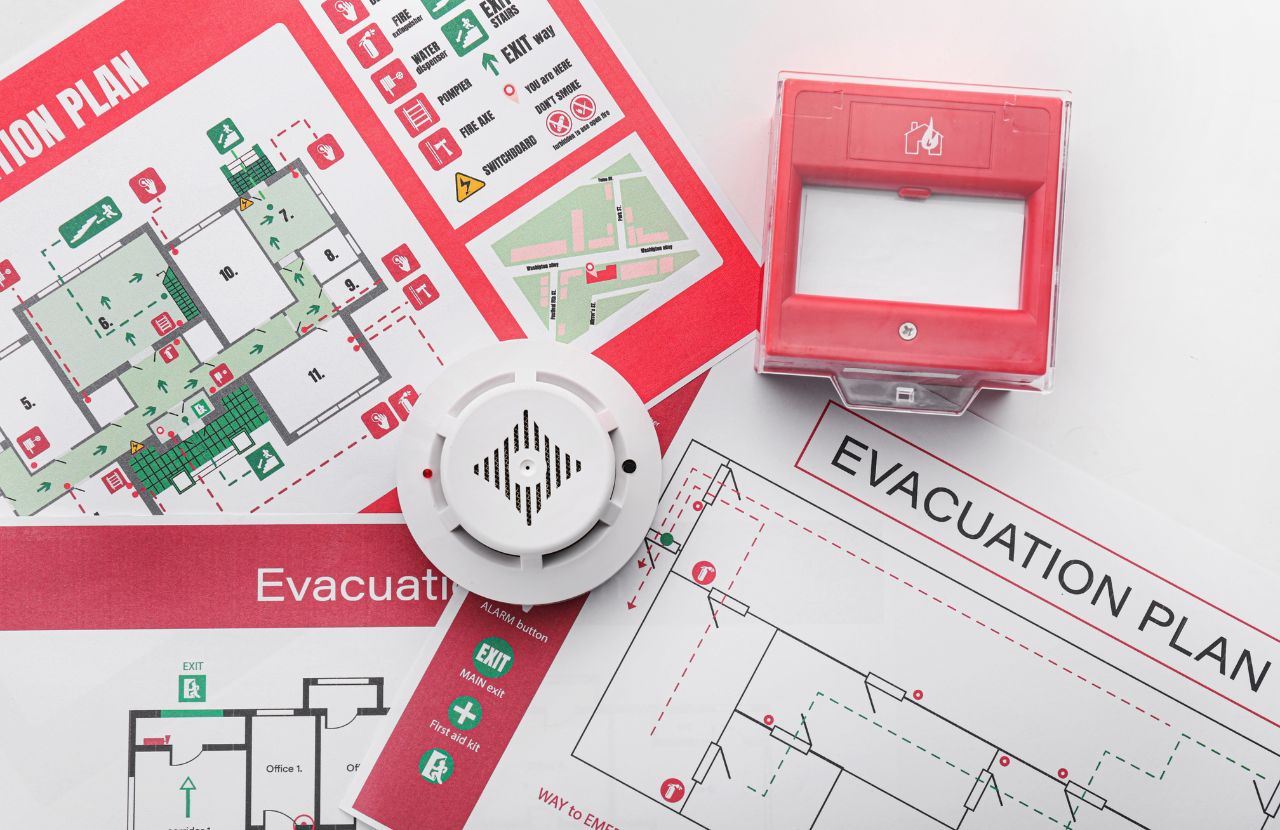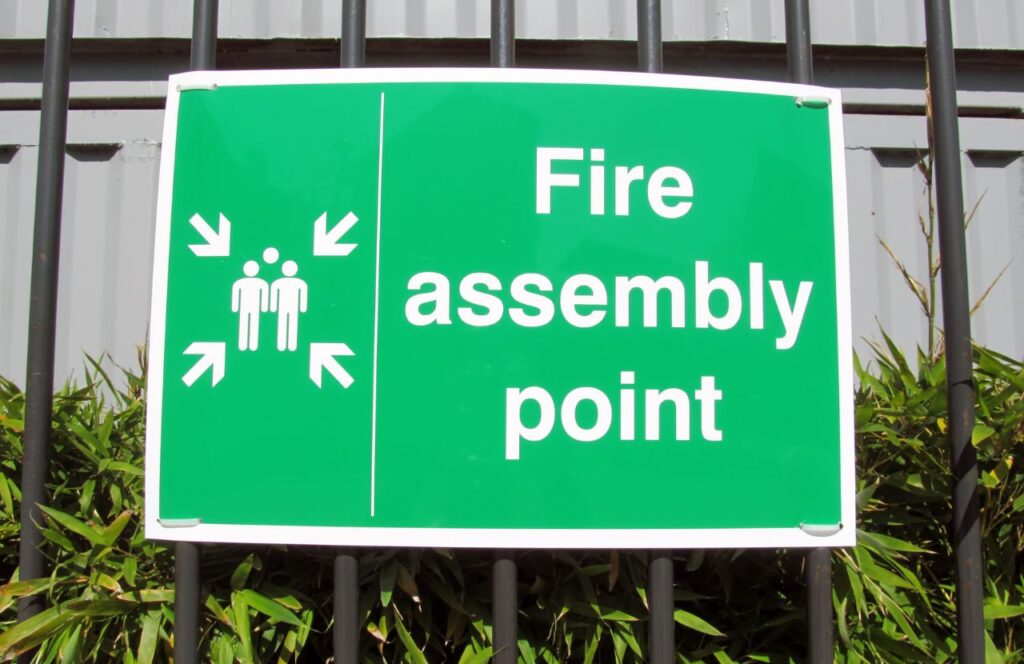
Having a well-structured fire evacuation plan (or ‘fire emergency plan’) in place helps to ensure a rapid, effective response to a fire to safeguard the lives of your employees and visitors. A fire evacuation plan is also a legal requirement under The Regulatory Reform (Fire Safety) Order 2005, Article 15.1 (a).
What must a fire evacuation plan include by law?
Under the Fire Safety Order, the person responsible for a non-domestic premises (the ‘responsible person’), must ensure a detailed fire evacuation plan is in place. The Order defines the responsible person as:
- The employer if the premises is a workplace.
- If the premises is not a workplace the responsible person is:
- The person who has control of the premises (as occupier or otherwise) because they carry on business, trade or another undertaking at the premises (for profit or not); or
- The owner of the premises, where the person in control of the premises does not have control in connection with the carrying on a trade, business, or other undertaking.
While the Order doesn’t say the plan must be in any particular format, it must be structured to cover the elements necessary to ensure a safe evacuation.
On 1st October 2023 Section 156 of the Building Safety Act 2022 (BSA) will come into effect, which amends the Regulatory Reform (Fire Safety Order) 2005. Once the changes are in force, all responsible persons will be legally required to formally record fire safety arrangements.
The legal requirement to formally record arrangements will no longer be restricted to those who employ more than five people, where the premises has a licence plate, or an alterations notice has been served. This will ensure that best practices are in place to safeguard employees and visitors, and to demonstrate legal compliance.
Does a fire risk assessment inform a fire evacuation plan?
The information gathered during a fire risk assessment supports the creation of an effective fire evacuation plan that is tailored to a workplace’s specific hazards and risks.
Conducting a fire risk assessment is a legal requirement under the Fire Safety Order. Although the responsible person can carry out a fire risk assessment themselves, they may choose to hire a competent fire risk assessor to do so.
Fire risk assessors have a thorough understanding of the potential hazards associated with different buildings and business types and are likely to identify hazards that would otherwise have been overlooked. They also understand how people behave when there is a fire, how fires develop, and how to safeguard groups of people who are at particular risk.
Our experienced fire safety consultants at Praxis42 review fire risk assessments and fire evacuation plans to ensure they are bespoke to a business’s activities, premises, and occupants, and meet up-to-date best practices and legal requirements.
What should you include in a fire evacuation plan?
A fire evacuation plan should clearly show that the following is in place:
Emergency contact details
Contact details for local emergency services should be included in the fire evacuation plan. The plan should also provide contact details for the responsible person and other key personnel (including out-of-hours contact details.
Procedures and responsibilities in the event of a fire
A fire evacuation plan must set out everyone’s responsibilities in a fire, so they know exactly what to do, including:
- Where the assembly points are.
- Who is responsible for headcounts to ensure everyone is safe.
- Who is responsible for dialling 999 to communicate with the emergency services.
- Who the fire wardens are and their duties.
- How vulnerable people will be evacuated (see below).
- Who is responsible for communicating evacuation instructions and giving updates during the evacuation process.
This information helps to ensure an organised, coordinated, safe evacuation of a building.

Assembly points
The plan should show that assembly points are located outside the building, at a safe distance from any fire. The location should be large enough to accommodate all employees and visitors and be clearly identifiable. Emergency services must be able to gain easy access to assembly points.
Communication and coordination with local emergency services
Organisations should establish efficient communication protocols with local emergency services to ensure that information is shared quickly and accurately in the event of a fire. This should be explained in the fire evacuation plan.
Certain businesses may benefit from providing additional information to local emergency services, such as building plans, emergency contact information, and details on hazardous materials or other potential fire hazards.
Clear escape routes and emergency exits
A fire evacuation plan should identify escape routes and emergency exits. There must be enough escape routes and emergency exits for everyone in the building.
Escape routes should be strategically planned to accommodate the expected number of occupants and must provide safe and efficient pathways to outdoor assembly points. Emergency doors must be easy to open.
Escape routes must be as short as possible, free of obstructions, and well-illuminated at all time so they remain visible even if there is smoke or low light. It’s important to ensure all emergency exits and escape routes are clearly marked with visible signs. There shouldn’t be any obstructions, such as furniture, equipment, and any other items that may block exit pathways.
Escape routes and emergency exits can be shown in floor plans or diagrams in the fire evacuation plan.
Staff fire training
A fire evacuation plan should include information about what staff training is in place to ensure employees understand fire prevention, how to recognise hazards, and the procedures to follow in the event of a fire. This should include Fire Refresher Training to reinforce employees knowledge of procedures and any updates to the fire evacuation plan.
Article 21 of the Fire Safety Order states that ‘The responsible person must ensure that his employees are provided with adequate training…’
The Fire Safety Order, Article 23, is also clear that employees have a legal duty to protect their safety and that of others, which means they must be equipped with the knowledge and skills to be able to do so.
The plan should specify the training designated fire marshals receive to carry out their roles effectively, if applicable.
Fire drills
Regular fire drills are essential to test the efficacy of a fire evacuation plan. Not only do they prepare everyone in the building for a fire, but any weaknesses can be identified and improvements made if needed.
Information about the frequency of fire drills and the steps that are followed when conducting a fire drill should be recorded in the fire evacuation plan.
In workplaces at least one fire drill a year should be carried out. More frequent drills are often required, especially if an organisation has sudden internal or external changes. It is advisable to have a fire drill when new staff join, so they understand the fire evacuation procedure.
After each fire drill, ensure you record any changes that need to be made to the evacuation plan. This may include adjusting exit routes, rearranging emergency equipment, updating staff responsibilities or improving communications between personnel.
After a fire drill, evaluate what went well and what must be improved and document any actions taken to address issues. Keep these records as part of the fire evacuation plan for future reference and proof of legal compliance.
Firefighting equipment
The evacuation plan should include information about the firefighting equipment on site. Equipment might include different types of fire extinguishers, fire hose reels, fire blankets, fire buckets, sprinkler systems and fire hydrants.
Firefighting equipment should be chosen based on the specific needs of the building and the level of risk identified in the fire risk assessment. Read our guide on how to identify different types of fire extinguishers.
The plan needs to map out exactly where fire equipment is located. Alongside location details it is advisable to provide instructions on how each type of firefighting equipment is to be used.
The importance of regular equipment maintenance and inspections should be clearly communicated in the plan, stating who is responsible for carrying out equipment inspections and how often this is done.
Close-down procedure
A close-down procedure should be included in the fire emergency plan to identify the critical processes or machinery that needs to be safely shut down in the event of a fire. This might include steps to shut off utilities. In some cases, this might be a task for trained personnel only.
How should you evacuate people with disabilities?
People with disabilities, such as mobility issues or other special needs may require a Personal Emergency Evacuation Plan (PEEP). Within the evacuation plan there should be an outline of the procedures for assisting vulnerable occupants during an evacuation. Vulnerable occupants could be members of the public, and therefore a Generic Emergency Evacuation Plan (GEEP) is required.
Conducting a fire risk assessment to determine the specific requirements of an individual is essential. This includes identifying accessible routes, evacuation chairs and other equipment or assistance that may be needed.
The PEEP should be thoroughly communicated to the person affected, their line manager and any other employees involved in the evacuation process. It is recommended to train all employees in PEEP and ensure that it’s incorporated into all fire drills.
Establish a communication protocol with emergency services so they are aware there is someone with specific disabilities in the building. Regularly review and update the fire evacuation plan to ensure it remains relevant and effective if that person’s needs or assistive equipment change.
How often should you review a fire evacuation plan?
We recommend that fire evacuation plans are reviewed at least annually.
It’s important to review a fire evacuation plan when there are changes such as a large intake of new employees, or if employees join who have specific disabilities.
The plan will also need to be reviewed if there are significant changes to the workplace layout, building structure, fire safety equipment, or processes. This could include renovations, expansions, or changes in building occupancy.
If there are changes in fire safety training methods or best practices, or regulatory updates then the plan will need to be updated to show how latest requirements are met.
Whenever the plan is reviewed a good idea to give existing employees a refresher on evacuation protocols.
Key takeaway
Remember that a fire evacuation plan is a dynamic document that should evolve with your organisation and its fire safety needs. Keeping the plan updated and conducting regular reviews will help ensure employees are well-prepared during a fire emergency, potentially saving lives.
Learn more about Praxis42’s fire safety consultancy services, including professional fire risk assessments.




